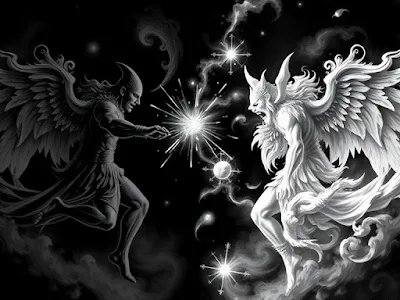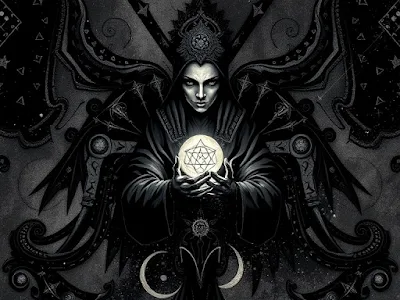In the vibrant tapestry of Indian culture, where
spirituality intertwines with daily life, the concepts of white magic and black
magic evoke strong emotions, fervent debates, and an almost mythic aura that
sparks the imaginations of many. As we delve into this fascinating topic, we
embark on a journey through the mystical, often misunderstood world of magic in
India, illuminating the nuances of white and black magic, and appreciating
their significance in Indian folklore and belief systems.
The Spectrum of Magic: An Introduction
At the core of our discussion lies the fundamental
understanding that magic—whether termed white or black—serves as a reflection
of our intentions and the energy we wield. In India, where magic and
spirituality have coexisted for millennia, the distinctions between white and
black magic can often blur, leading to intriguing interpretations.
What is White Magic?
White magic is often described as the practice that seeks to
harness supernatural forces for the purpose of good—healing, protection, and
the promotion of well-being. It embraces positive intentions, often aiming to
help others or improve one’s surroundings. In India, practitioners of white
magic may be referred to as healers, sages, or even wise women, depending on
the community.
Local Variations and Practices:
Whether it’s through ancient rituals, herbal remedies, or
mantras chanted in sacred languages, the methods of practicing white magic in
India are as diverse as its culture. Influenced by traditions such as Ayurveda,
yoga, and various spiritual schools, white magic can manifest in numerous
forms:
1. Healing Rituals: Many practitioners engage
in “pujas” (rituals) that invoke deities for divine healing, using offerings of
flowers, fruits, and chanting of mantras for positive energy.
2. Astrology and Gemology: In the belief that
certain celestial alignments can affect human lives, astrologers often use the
power of gemstones, recommending which stones can bring luck, health, and
prosperity to individuals.
3. Shamanistic Practices: Tribal healers in
remote parts of India utilize indigenous methods, calling upon the spirits of
animals and nature to restore balance and health within their communities.
The Essence of Black Magic
Conversely, black magic is perceived as the darker
counterpart to white magic, associated with malevolent intentions and the
desire to manipulate circumstances for personal gain or harm. In India, the
term “kaala jadoo” conjures images of curses, hexes, and a realm of the
supernatural shrouded in mystery and fear.
Cultural Perspectives:
Black magic in India isn’t just a product of folklore; it’s
deeply rooted in cultural narratives, often passed down through generations.
Here’s how it typically manifests:
1. Curses and Hexes: Stories abound of
individuals seeking vengeance or justice through malefic rituals. These tales
often serve as cautionary narratives, warning against the repercussions of
darker practices.
2. Tantric Rituals: While often misrepresented
in mainstream representations, some Tantric practices—rooted in ancient
spiritual traditions—can be misused for invoking dark energies. Such practices
are complex and require rigorous discipline for both creation and control.
3. Fear and Superstition: The fear of black
magic often leads to societal hysteria, resulting in accusations and witch
hunts. This aspect emphasizes the power of belief and consciousness in the
perception of magic as white or black.
The Socio-Cultural Implications
The discussion of white vs. black magic in India transcends
mere definitions; it dives deep into the socio-cultural fabric of society.
Magic in its various forms can reflect the fears, hopes, and moral codes of
communities.
Crisis
and Confusion:
One of the profound implications of black magic is its
association with negative societal behaviors. Accusations of witchcraft often
lead to violence against individuals, predominantly women, labeled as
practitioners of black magic. This dark side highlights how the fear of the
unknown can manifest in harmful ways.
Conversely, white magic, with its association of goodness
and healing, has a potent influence on community life, often bringing
individuals together in collective rituals, fostering unity, and enhancing
social bonds.
Modern Misconceptions and Media Representation
In today’s digital age, the representation of white and
black magic in Indian cinema has played a dramatic role in shaping public
perception. From thrilling horror films about black magic to heartwarming
stories of white magic that illustrate the triumph of good over evil, these
portrayals often exaggerate or distort reality.
Bridging Tradition with Modernity
As we navigate through the 21st century, the dialogue around
magic—both white and black—has evolved. Contemporary practitioners of white
magic increasingly integrate modern approaches, such as psychological healing
and holistic wellness techniques, reflecting a shift towards more compassionate
forms of magic.
The Path Forward: Embracing Responsible Practice
Ultimately, the key to understanding the nuances of white
and black magic in India lies in fostering a responsible and respectful
approach to these ancient traditions. Here are a few steps towards that end:
1. Education and Awareness: Learning more about the
roots of magical practices can debunk myths and misunderstandings. When armed
with knowledge, communities can differentiate between folklore and
exploitation.
2. Empowerment and Healing: Seek healing practices
that embody the true essence of white magic—compassion, support, and community
cohesion. This includes encouraging open dialogues about mental health,
well-being, and spiritual practices.
3. Respect for Cultural Differences: Recognizing and
honoring the diversity of magical practices across various Indian communities
not only enriches our understanding but also fosters a spirit of inclusivity
and unity.
Conclusion: The Magic Within Us
In conclusion, the concepts of white magic and black magic
in India are layered and multifaceted, steeped in history, culture, and the
complexities of human emotion and intention. By embracing the positive aspects
of these traditions and standing firm against the dark manifestations of fear
and superstition, we can cultivate a society where magic—both white and
black—transforms into a force for good.
Whether through healing rituals, empowerment, or even the
challenges we face when confronting the unknown, magic is not solely an
external force; it also lies within us, a reminder of the incredible capacity
we have to shape our lives and communities for the better. Let us celebrate
this journey of enlightenment, bridging ancient beliefs with modern
understanding, and perhaps rediscovering a little magic in our own hearts along
the way!
Video Link











